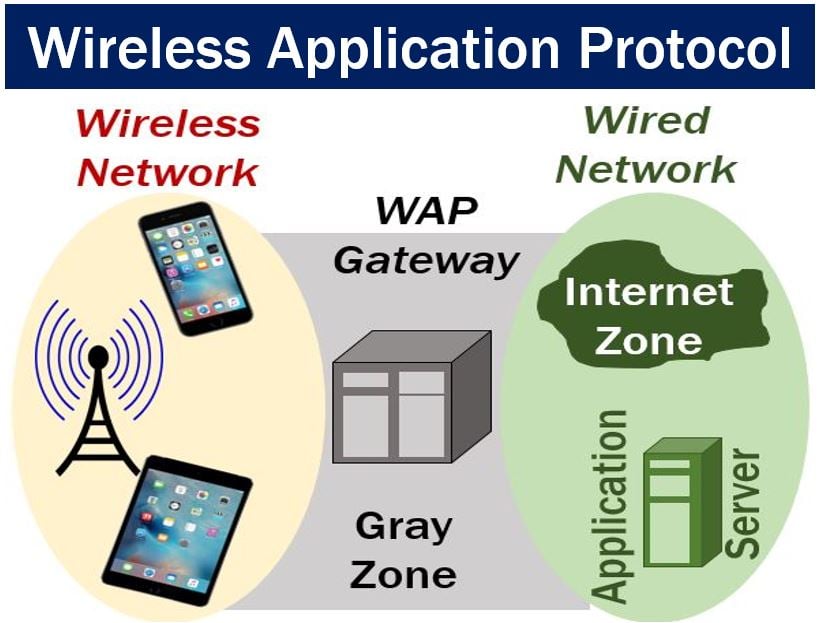Wireless application protocol (WAP) – definition and meaning
Wireless application protocol (WAP) is a suite of emerging standards to enable the viewing of mobile devices such as mobile telephones and tablets, i.e. mobile Internet applications. The wireless application protocol was created as a result of the WAP Forum that was formed in June 1997 by Nokia, Motorola, Ericsson, and Unwired Planet. The WAP Forum was created with the aim of assisting the convergence of two rapidly-growing network technologies:
– Wireless communications
– The Internet
The convergence is based on the dramatic effect of e-business over the Internet and the rapidly-growing number of people with mobile telephones and tablets.
These two technologies are expected to have a massive impact on current e-business practice – their combination will create huge market potential.
According to SearchMobileComputing.Techtarget.com:
“WAP (Wireless Application Protocol) is a specification for a set of communication protocols to standardize the way that wireless devices, such as cellular telephones and radio transceivers, can be used for Internet access, including e-mail, the World Wide Web, newsgroups, and instant messaging.”
“While Internet access has been possible in the past, different manufacturers have used different technologies. In the future, devices and service systems that use WAP will be able to interoperate.”
Before the introduction of wireless application protocol, mobile service providers had limited opportunities to offer interactive data services.
 According to Webopedia, Wireless Application Protocol is “a secure specification that allows users to access information instantly via handheld wireless devicessuch as mobile phones, pagers, two-way radios, smartphones and communicators. WAP supports most wireless networks. These include CDPD, CDMA, GSM, PDC, PHS, TDMA, FLEX, ReFLEX, iDEN, TETRA, DECT, DataTAC, and Mobitex.” (Image data sourced from http://docs.oracle.com)
According to Webopedia, Wireless Application Protocol is “a secure specification that allows users to access information instantly via handheld wireless devicessuch as mobile phones, pagers, two-way radios, smartphones and communicators. WAP supports most wireless networks. These include CDPD, CDMA, GSM, PDC, PHS, TDMA, FLEX, ReFLEX, iDEN, TETRA, DECT, DataTAC, and Mobitex.” (Image data sourced from http://docs.oracle.com)
Wireless application protocol – several components
The wireless application protocol standards consist of a number of architecture components, including:
– Wireless Application Environment (WAE)
– Wireless Transport Layer (WTP)
– Wireless Session Layer (WSL)
– Wireless Transport Layer Security (WTLS)
These features and components together define how mobile phones and tablets – wireless data handsets – communicate over the wireless network, and how services and content are delivered.
With the WAP standards, a mobile phone, for example, can establish a connection with a WAP-compliant wireless infrastructure, request and receive the services and content, and present them to the consumer (end user).
This WAP-compliant wireless infrastructure may include the server side infrastructure, the handset, the application server, the Web server, and the telecommunication company (network operator)
The convergence of the e-business over the Internet and wireless technologies has led to emerging and rapidly-growing wireless e-business, including mobile commerce.
E-business has attracted increasing attention of business leaders and academic researchers. Being able to do e-business anytime and anywhere started off as a reality and has become a basic business necessity.
However, due to the wireless’ limitations, conducting e-business in the wireless environment is more difficult than in the wired world.
In an article titled ‘Wireless Application Protocol’, W. Kou, from Xidian University in China, wrote:
“Understanding the wireless application protocol that the wireless e-business relies on is important for developing and deploying wireless e-business. In this chapter, our discussion was focused on wireless application protocol and related wireless security.”
Video – How to use wireless application protocol
This Howcast video explains how to use WAP and how it has changed what our mobile devices can do.

